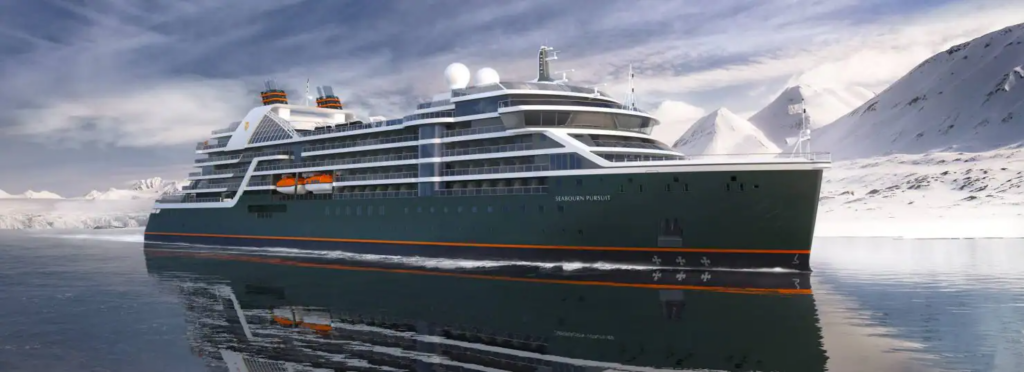South Georgia may include the following experiences. The exact itinerary is subject to permissions, weather, ice conditions and time available. The daily program will be determined by the Expedition Team and is subject to site availability.
Cooper Bay, South Georgia
A wealth of wildlife and awe-inspiring scenery reward those who visit Cooper Bay, a hidden gem awaiting discovery at the southeastern-most extremity of South Georgia. Four species of penguins nest and breed at Cooper Bay, including the island’s largest chinstrap penguin colony, together with colonies of macaroni and gentoo penguins and a small number of king penguins.
While macaroni penguins are the most abundant species on South Georgia, with numbers estimated at ten million, they are usually extremely hard to find. Elsewhere, they nest on inaccessibly high cliffs and steep rocky slopes, making Cooper Bay one of the few easily accessible locations. Giant petrels and both light-mantled and sooty albatrosses find safe nesting sites among the waist-high tussock grass that covers the steep slopes above the bay. Masses of fur seals swarm the beaches and are often seen playing in the kelp beds offshore.
Cooper Bay was named after Robert Cooper, First Lieutenant of James Cook’s ship HMS Resolution that visited here in 1775.
Drygalski Fjord, South Georgia
Drygalski Fjord is one of the most scenic areas of South Georgia, and also one of the windiest. Its narrow, two-and-a-half mile (4 km) waterway is bordered by steep-sided rock walls crowned by spectacular snow-covered peaks rising to over a 3,200’ (1,000 m). At the head of the fjord looms the mass of the Risting Glacier. The sharply pointed ice pinnacles and deep blue crevasses of its massive face occasionally send huge blocks of ice thundering into the water.
Despite its impressive and seemingly inhospitable appearance, Drygalski Fjord supports a surprising amount of wildlife. This is the main breeding area in South Georgia for snow petrels. Blue-eyed shags, Wilson’s storm petrels, and Antarctic terns are common visitors, and the fjord is also the northernmost recorded breeding site for Weddell seals.
The fjord was named to honor Professor Eric Von Drygalski, leader of the First German Antarctic Expedition of 1901-03.
Fortuna Bay, South Georgia
Scenic Fortuna Bay offers both prolific wildlife viewing and a magnificent panorama from its beach of jagged summit peaks and the impressive expanse of the Konig Glacier. Named after the first whale-catcher to operate here in the early 1900s, Fortuna Bay was used by early explorers and sealers long before the establishment of whaling stations on South Georgia.
It boasts a large population of elephant and fur seals along its mile-and-a-half (2km) long pebble beach. Seal pups congregate here in huge numbers. The curious pups run to and fro, playing frisky games and exploring the world around them, resembling a chaotic animal kindergarten. The bay also supports a colony of several thousand photogenic king penguins, the largest on South Georgia.
The best-known human history of Fortuna Bay comes from the tribulations of Sir Ernest Shackleton. It was here that he and his companions descended to the bay in 1916, after a treacherous crossing of the island’s ice cap, to reach their rescuers at the Stromness Whaling Station.
Gold Harbour, South Georgia
Gold Harbour, its small, crescent cove framed by the glacier-covered peaks of the Salvesen Range, is regarded as one of the most beautiful areas in all of South Georgia. The prominent icefall of the Betrab Glacier hangs dramatically from the cliffs above, from time to time releasing a large ice block to fall thundering into the sea.
The highlight of a visit to Gold Harbour is the large colony of king penguins that covers the length of the beach. Raucous penguin calls fill the air with never-ending whistles and chatters as fluffy penguin chicks roam the beach in search of their parents. A small gentoo penguin colony has tucked itself in amongst the grass nearby. Massive elephant seals, weighing thousands of pounds, lounge at the water’s edge, while leopard seals lurk off the beach in hopes of a careless penguin. Above, light-mantled albatrosses glide along the cliff faces as giant petrels hover over the colony.
Grytviken, South Georgia
Tucked in at the head of King Edward Cove and encircled by steep rugged mountains is the capital of South Georgia, Grytviken. It was established by the Norwegian captain Carl Larsen in 1904 as the island’s first land-based whaling station, and its name literally means “Pot Bay” for the number of seal- oil try-pots left here by early sealers.
Over 300 people lived in Grytviken during its busiest years. Nowadays it resembles a ghost town strewn with the remnants of rusty oil tanks, oil processing plants and the skeletons of derelict whaling vessels. The house of the station manager has been restored to become the South Georgia Museum. The Lutheran church and the white crosses of the cemetery are restored to their former state and stand in stark contrast to the verdant green peaks above. A monument marks the grave of the heroic British explorer Sir Ernest Shackleton, affectionately known by his men as ‘the boss.’ Grytviken also has its own post office, selling unique South Georgia stamps, while across the cove is the British Scientific Station at King Edward Point.
Salisbury Plain, South Georgia
Salisbury Plain is a stunningly beautiful place to visit. It was deposited by retreating glaciers along the shore of the Bay of Isles, and resembles an open stage rimmed by a towering amphitheater of snow-capped mountains. Its name first appeared on British Admiralty charts in 1930 and likely refers to the similarly named feature back in England.
Salisbury Plain is home to the second largest king penguin colony on the island. It is immense in size and overwhelming in numbers, with over 250,000 birds nesting, breeding, and molting on its shores. Penguins are everywhere, dotting the beach and covering the adjacent hillsides. A cacophony of trumpeting and chirping adult penguins and whistling chicks fills the air against a rhythmic backdrop of the surf crashing on the beach.
One of South Georgia’s largest elephant seal populations also comes to haul out along this 1.8 mile (3 km) long pebble beach. Fur seals are here in great abundance, hustling between penguin congregations and clusters of massive elephant seals in a scene of controlled biological chaos!
South Georgia
Remote and forbidding South Georgia, the most rugged of all sub-Antarctic islands, digests the fury of the stormy Southern Seas. The island’s dramatic glacier-covered mountains rise sharply and are crowned by Mount Paget at 6,900’ (2935m). Some 50 percent of South Georgia is permanently covered by glaciers, nourished by the proximity of the Antarctic Circumpolar Current.
The cold, surrounding seas in this area the most nutrient-rich on earth, and make South Georgia a mecca for wildlife. Amidst the vastness of the Southern Ocean, it is a place of pilgrimage for penguins: a place to feed, to breed, and to rear young. Over 250,000 king penguins return to South Georgia annually, transforming its bays and beaches into a mosaic of motion and sound. Several other species of penguins, along with skuas, petrels, albatrosses, pipits and other birds nest along its shores. A few million fur seals hustle about like playful puppies, and hundreds of thousands of elephant seals gather in haul-outs so unimaginably immense they must be seen to be believed.
St Andrews Bay, South Georgia
Few places on earth are as immensely grand as St Andrews Bay. This is a place of such sheer vast scale that it must be truly experienced to be believed. Its wave-battered, windswept beaches border a broad plain left behind by retreating glaciers, their white snouts clearly visible at the base of the mountains.
The desolation left behind by the glaciers didn’t stay vacant for long. The void was filled by literally hundreds of thousands of king penguins, gathering in one of the largest colonies on earth. Take the time to climb onto the crest of the moraine view to the unforgettable sight of a sea of penguins standing shoulder to shoulder. One of the largest Elephant seals haul-outs on the island is also here. In the early summer months, the beach seems carpeted by animals, an ever-changing labyrinth of massive gray forms and shapes. They growl and grunt while the wails and whimpers of fur seals fill the air from afar.
Stromness, South Georgia
The name Stromness is tied in history books to one of the greatest human endeavors of adversity and hope ever recorded. It was here that Sir Ernest Shackleton and his companions arrived in 1916 after an arduous 36-hour crossing of the island, traversing uncharted ice caps and treacherous mountain terrain, and finally reached this remote outpost of civilization.
Stromness Bay on the northern coast of South Georgia once housed a prominent whaling station. Established in 1907 as a site for a factory ship, it was enlarged in 1912 when the processing moved on shore. Buildings were constructed, and the population of the station dramatically increased. In 1961, it was abandoned to the mercy of the elements, and today the station’s ghostly appearance has given way to the forces of nature. Fur seals have reclaimed the bay and the occupy the ruins. Often, hundreds of fur seal pups only a few weeks old congregate on the beach and around the station, playing, fighting, hustling and running among the remnants of the abandoned equipment.
Less
More




















